1995
March 31 1995 (and periodically into 1996)
Abbey Road Studio Two/Penthouse Mixing Suite. Mixing/Editing (precise mixing details
unknown) : (variousl tracks that appear on The Beatles Anthology Vol 1-3 releases, bonus tracks on Free As A Bird single releases and Real Love single releases).
P: George Martin. E: Geoff
Emerick.
The Beatles had blown out of Abbey Road Studio Two a long
time ago; in fact the last time all four Beatles were there
together was the 20th of August 1969.
When they returned together in 1995 there
was still an ancient Hammond organ sitting on the battered parquet floor in the
famous Studio Two. There was an old Steinway upright in the corner. And the
famed sounds effects closet, which the band members raided like school children,
was still under the stairway, empty now except for a thunder machine, a
cardboard box full of tambourines and a flickering florescent light.
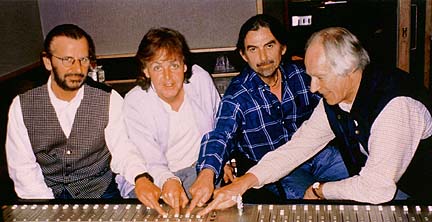
Allan Rouse (co-ordinator and assistant to George Martin): It was March 31, a day I shall never forget. I was in Studio Two control room at the time, playing back some more archive recordings to George Martin. At any other time, this would have been par for the course, but on this occassion were joined by Paul, George and Ringo. This was the first time all four of them had been back in that studio since 1969, and quite honestly the atmosphere can only be described as sheer magic. They were all totally at ease in each others company, taking photographs and videos and obviously enjoying the unique occasion as much as everyone else.
Paul: It's strangely unchanged. Studios One and Two are
largely unchanged. But Three is modern. Two, well, they don't wanna change the
room that 'got' the Beatles. And it got a lot of Cliff's
early good stuff, Move It, Living Doll. And now Oasis.
EMI is like the Beeb, it has rules. And we used to make a lot of noise, doing
things like Helter Skelter or a loud track anyway, and you'd always
get the classical guy next door - in our time it was Daniel Barenboim's
producer - going bang, bang, we're doing a quiet classical piece and we can hear
you though the walls. The walls obviously aren't that good for soundproofing.
And we'd be going, under our breath, fucking bastard classical, we subsidise
them! However we would turn it down a little bit, pull out a bit of a sulk, put
the acoustics on. We lived with it.
Harrison, McCartney and Martin
went for a nostalgic meander on their first day back at Abbey Road, popping into
Studio Three where a dumbfounded Michael Nyman, composer of
The Piano soundtrack, was recording. Mel
Gibson, observing the soundtrack recording for Braveheart
in Studio One, was overcome when he learned that Paul,
George and Ringo were in the same building
on their first day here together for something like twenty five years (by an odd
quirk of fate, it was George, Paul and
Ringo who attended the very last group session here, again
without John, on the 3rd of January 1970).
During the afternoon, they even decided to pop down to the canteen for a snack.
Doreen Dunkley: They just strolled in as natural as anything, there were no airs or graces, they just served themselves with salad, tea and coffee, and then apologising for any inconvenience, asked if it were possible for me to get them a large bowl of chips. Then they took their meals, sat down at one of the tables and tucked in. I stood there at the bar, totally fascinated by the casual presence of these idols from my past. Mind you, I couldn't help thinking how sad it was that John wasn't there with them.
Nostalgic sightseeing eventually put aside, the group finally got down to work, sitting down to listen to some of the hundreds of hours of tapes George Martin had been painstaking combing through over recent weeks.
Paul: There were those same steps up to virtually the same control room. And then just looking at each other, older and slightly different maybe, but nevertheless it was still three of The Beatles sitting there; and with who? George Martin; and what boxes were we looking at? The actual boxes from the sessions. And although it sounds silly, I swear to god, as we played the tapes I was praying that I wouldn't make a mistake.
George Harrison: The main gist of it with the music is to
find the most ancient Beatles music possible and come in
chronological order through the various other records we made and bring it up to
date.
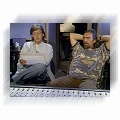
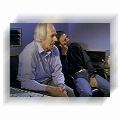

Paul McCartney: It's deja vu, actually. We're sitting in
Abbey Road Studio Two, where we always worked, listening to the work we did when
we were twenty. It is quite strange but it's exciting as well. It's like being
archaeologists. We're actually finding tracks that we didn't remember recording,
that we didn't want, or thought 'No, that's not too good'. Now of
course, after thirty years, they don't look too bad at all. There were obvious
reasons why a lot of the stuff didn't make it into the shops, but we're not
looking at it from a recording quality point of view. It's history, and what
we've been putting together is an historical document.
George Harrison: There are some funny songs, there are some songs that we didn't even remember. I heard this song that Ringo's singing, I still don't know the title of it, but it's got the most amazing lyrics and it's a quite a good production. And quite a good tune. I don't recall what it was, but the words are just like ridiculous...
Paul McCartney: It's been trippy going through it all, sitting
there in Abbey Road with George Martin and George
and Ringo trying to make some sort of story. God it’s so
strange after all this time.
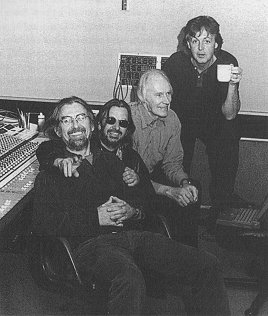
George Martin: It so happens that there is a take one of Yesterday that is charming and exquisite and of course, it doesn't have any string quartet on it and we're putting that out. I think people will like that. There's one version of And Your Bird Can Sing when they were overdubbing a final track and they started giggling and they went through the song and they completed it but it was just giggles all the way through and you can't help laughing with them. It's so funny.
Paul McCartney: It's interesting to hear George Martin now saying, Why did we have to go to take thirty-six? I know what he means, I can only assume it was part of the creative process, you know, keep on till we get better. But looking back on it, take two was often better, particularly when you listen to Anthology 3, because by the time take twenty-six or thirty had arrived, we'd lost the enthusiasm for the tune. Yes, we were getting slicker and more in tune, but what I like about the early takes is the 'soul' on them. You can really hear us enjoying ourselves on songs like Dig A Pony, Let It Be, The Long And Winding Road and Two Of Us.
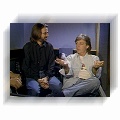
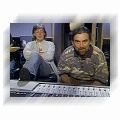
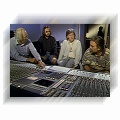
Paul McCartney: In an outtake I heard recently - recording Dizzy Miss Lizzy - John is saying 'What's wrong with that?' and George Martin says 'It wasn't exciting enough, John.' and John mumbles 'Bloody hell...' I think that's just pressure of work.
The mixing sessions continued well into 1996 (see the Early 1995 entry for more details), with George Martin, Mark Lewisohn and Allan Rouse continuing the search for material while the Beatles frequently popped in to check on progress and veto tracks.
George Martin: Of
course they couldn't sit through all the sessions, so I would tend to have them
come in about once a week.
The special features disc on the Anthology DVDs features a large amount of footage of the Beatles at Abbey Road taken in May 1995. The group can be seen at the control desk with George Martin having a whale of a time listening to the multitracks of Tomorrow Never Knows and Golden Slumbers ('which album is this?' Harrison frowns, much to the amusment of Paul and Ringo). It's also worth noting that Harrison has obviously been studying the Tomorrow Never Knows multitracks at some stage before this playback session with Paul and Ringo. Despite rumours of tensions, George, Paul and Ringo seem remarkably relaxed and friendly with each other, constantly laughing and making jokes at each other's expense. The footage is, in fact, one of the highlights of the entire Anthology project.
Paul McCartney: It has given me the opportunity, for example, to take all the strings and heavenly voices off The Long And Winding Road, which I never really intended in the first place.
Among those tracks considered for inclusion, but ultimately vetoed, were
Love Of The Loved and To Know Her Is To Love Her (both from
the Decca audition), Red Hot (live from Hamburg), She's A Woman
(live from Shea Stadium), Think For Yourself, Love You To,
Paperback Writer (vocal only rendition), Nowhere Man (live
from Tokyo), Getting Better, Magical Mystery Tour, the
mysterious Hey La Le Lu / All Together Now and the legendary 27 minute
version of Helter Skelter (all EMI studio tracks unless otherwise
specified).
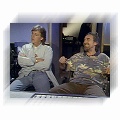
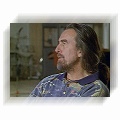
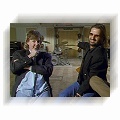
George Martin: The live recordings we listened to from the
Cavern and Hamburg were too poor to consider.
Alternate EMI takes of From Me To You, Getting Better,
Magical Mystery Tour, Yer Blues and Paul’s demo of
Goodbye were included on a reference DAT prepared in mid 1994
featuring material slated for the Anthology CDs.
Apple is also believed to have acquired an acetate of Paul
singing an acoustic version of Love Of The Loved.
The live Quarrymen tape with John
singing Putting On The Style and Baby Let’s Play House
(recently purchased at auction by EMI) also had some work done on it, but was
eventually omitted (possibly due to the extremely poor quality of the
recording).
Some mixing work was apparently also done on several of the White Album demos that circulate on bootleg (apparently sourced from John's copy of the tapes), but the poorer sound on these recording clashed with the limited selection of quality tapes (reportedly only eight songs) that George Harrison handed over. A few years earlier Harrison had claimed to hold a copy of the entire tape.
Harrison apparently also insisted on the editing of the complete You Know My Name (Look Up The Number) (to the point of editing the track himself) and the deletion of thirteen seconds from Shout. In both cases his reported reason was that the tracks were self-indulgent.
Paul McCartney apparently wanted Carnival Of Light
on Anthology 2 but George,
Ringo and Yoko didn't, and there was also
speculation that George and Ringo originally
vetoed Come And Get It from Anthology 3
because it was never intended for the Beatles.
The Anthology videos also include a large number
of small selections from the EMI archive tapes, including many takes and alot of
Beatles studio chat that didn't make it onto the CDs.
Most of this material was presumably chosen, edited and mixed during these
sessions.
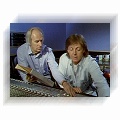
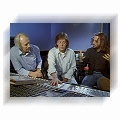
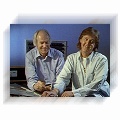
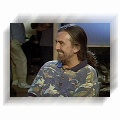
Neil Aspinall: The Beatles didn't hold
anything back from the three Anthology CDs.
Everything they thought was worth releasing is on those three CDs.
Sources include: Allan Kozinn; The Complete Beatles Recording Sessions
- Mark Lewisohn (Hamlyn Publishing 1988); Fixing
A Hole - LRE King (Storyteller Productions
1989); Mojo Magazine Dec 95; Abbey Road - Southall/Vince/Rouse (Omnibus Press 97); Independent On Sunday 16th Jul 95; Q Magazine Jun
97; Beatles Monthly No. 235 Nov 95, No. 236 Dec 95, No. 249 Jan 97 (Beat
Publications)
Last Entry : 20th & 21st March 1995 Session
Main Contents
Next Entry : 15th & 16th May 1995 Session